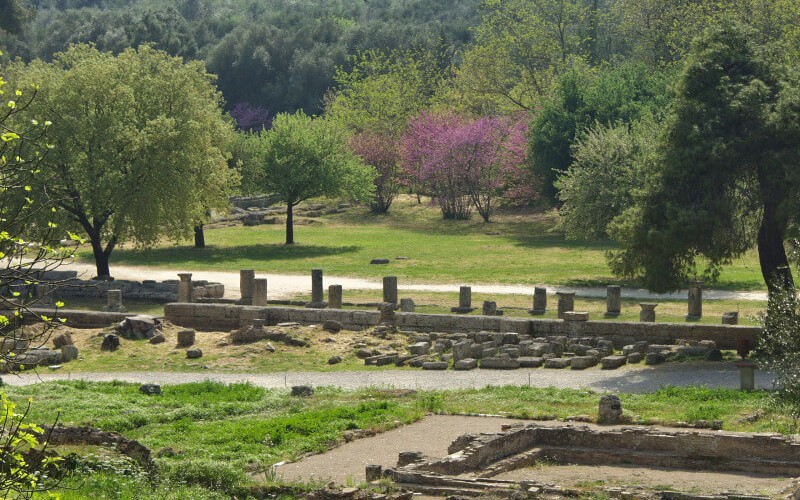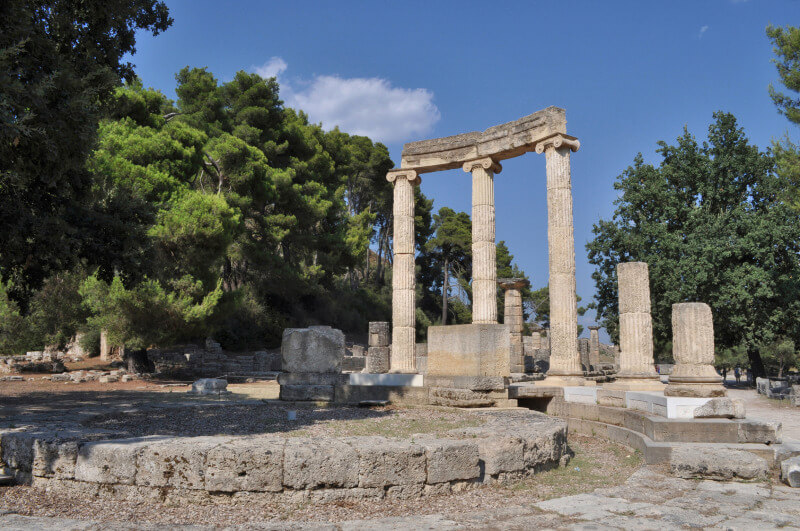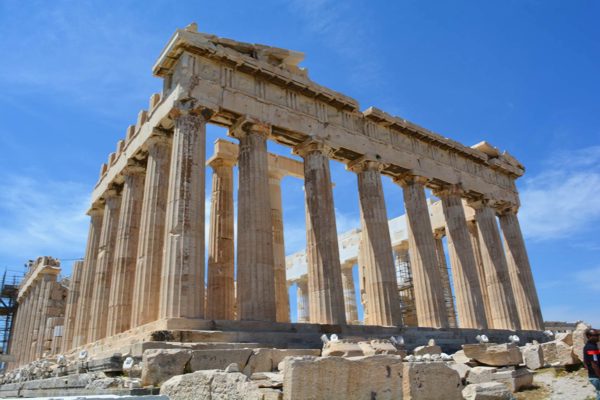ancient Olympia in Google Maps
The Olympic Games
The Games held in ancient Olympia Greece, were actually called “Olympia” and they were dedicated to Zeus, god of gods and humans. He lived on Mount Olympus (central Greece, Macedonia region, altitude 2,918 meters) governing the world and the gods.
The Olympic Games, nowadays an international symbol of culture and sports, are organized every four years and held in different countries. In antiquity, during the games there was a respected ceasefire to any hostilities happening. It was a message of reconciliation and peace between people.
The games were so important that actually became a system of chronology in antiquity, acting as kind of a calendar.
Cities sent athletes that would represent them and would be worthy to compete for the cities’ honor. There must have not been more fame in ancient Greece, but to return home, victory from the Olympics.
When the Olympic champions returned to their city part of the walls were demolished to let pass the hero. A city with an Olympic champion does not need walls to protect herself. That was the idea!
The games were full of glory for the winners, which is good since the “humble” prize was an olive wreath! This wreath gave glory equal to a hero and would give respect and eternity to a winning athlete’s name.
Posthumous fame was something regarded precious in ancient Greece, and Olympic champions were granted to have it. Lists with names of ancient Olympic champions are preserved until today. So, well, they weren’t wrong at all!
Where is located ancient Olympia?
Ancient Olympia is located in the south-eastern Peloponnese and belongs in the prefecture of Ilias, and by car is about four hours’ drive from Athens. You can go by bus, rent a car or take an organized tour to Olympia with a tour guide who visits the site.
As I am rent-a-car lover, after more or less 3.5 hours I reached ancient Olympia. I stopped a couple of times for a coffee break and to watch the Canal of Corinth.
The place is very green because of Alpheus and Cladeous rivers. The archaeological site – on which side locates the museum – requires some walking. In addition to high value in terms of history, for people who love sports and who honor the ideals of sports such as competing with honor, effort, fighting spirit, Olympia will excite them even more.

Visit Greece – Stadium at ancient Olympia
When I first saw the stadium of Ancient Olympia I felt awe. The place is not like probably many people might imagine it. No platforms have survived no tall stone buildings, no fancy buildings and such. You can see the stadium surround in the nature simply by its shape. Looking, walking or running around the stage is something you get an inner call to do!
If you just consider the fact that where you’re just standing, thousands of brave athletes competed in antiquity, for winning victory and to honor the god of gods and men, Zeus. The tour in this area is memorable. Any serious guide book or site will give you an idea of what you are going to see and what το expect. Some prehistoric findings are dated to 2,800 BC.
Some history about the place
The giant temple of Jupiter was the home of the gold and ivory statue of Zeus, made by Phidias and labeled in antiquity as one of the Seven Wonders. The Temple of Hera, dedicated to the homonym goddess, wife of Zeus. In honor of her there was held the “Heraia” athletic competition. This is a type of road race only for women. This is fitting, as women were forbidden from participating or even attending the Olympics.
The circular building, called Philippeion, was donated by Philip II (father of Alexander the Great).

Visit Greece – Ancient Olympia archaeological site
The Stadium, approximately 192 meters in length had a capacity of 40,000-45,000 spectators.
At the time, “stadium” was used as a unit of measuring length.
The Gymnasium, the Palaestra, the Bouleuterion, the workshop of artist Pheidias and many more places are waiting for us.
The road leading to the Stadium of Olympia remains deeply engraved in my mind. The entry is through an arch that still exists. Before visiting, I had refreshed my memory reading the previous day with things about ancient Olympia and the Olympic Games. Perhaps this is why my impressions have been so very powerful and colorful.
To this end, I recommend, before visiting the site, if you feel, take some amount of time to read the absolutely necessary bits that you should know about the site. When you’re visiting the archaeological site or the museum, your reading will all emerge from your memory, giving you an even richer experience. Read before bed, and you may dream yourself next to an ancient Olympic champion like Irodoros, Chionis or Ipposthenis!
Unfortunately, in addition to natural phenomena -earthquakes, overflowing rivers, landslides etc.- the human factor played primary role in the destruction of the place.

Visit Greece – Ancient Olympia GREECE
The last Olympic Games were held in 393 AD and after that Theodosius I issued a decree where all “pagan” holidays were banned. Christianity was the new religion of the Empire, so no more “pagan things” were allowed.
During the Roman occupation ancient Olympia was repeatedly looted.
Emperor Theodosios II, in 426 AD gave an order to burn to the ground the Temple of Zeus. A point of no return was marked in the history of Olympia and its great games that took place for almost 12 centuries!
The Olympics were, of course, reborn in Greece. The first international, modern Olympic Games were held in the capital of Greece, Athens, in 1896, at the Olympic Stadium “Kallimarmaro“ located in the city center.
It’s a Stadium made entirely of marble, restored at the end of the 19th century. This stadium was used during ancient times for a part of the celebrations of the “Pantathenea” a ceremony in honor of goddess Athena, the protector of the city, and was built in 329 BC.
Since 1896, the games are held every four years in a different city around the globe, promoting friendship between nations, sending a message of hope and reconciliation between men.

Visit Greece – The Parthenon, Athens Greece
However, the touching Lighting of the Olympic Flame is held in Kallimarmaro, where the Games were born. In Olympia, the Hellenic Olympic committee is responsible for the Ceremony.
According to the ritual, the High Priestess proceeds to the lighting at the Heraion, the temple of Hera. She calls for the god of Sun, Apollo, to light the torch by making a prayer.
The fire is a symbol of the victory of Humans, who once managed to steal fire (thank to Prometheus) from the gods, and a symbol of freedom. The Olympic Flame is then transported by runners holding a lit torch with the fire got from Olympia to the city where the current Games will take place. The ceremony of the Lighting of the Olympic Flame announces to the entire world the beginning of the Olympic Games.
I couldn’t resist the temptation and I ran around the stadium. I felt the vibes, the energy of the place! Was it true; was it all in my imagination? I couldn’t care less. I only know what impressed me, what struck my mind. This unique feeling of knowing that that little voice inside me saying: “I ran where ancient Olympians were running …” was not lying. No need to analyze it further.
The Museum of Olympia
As for the Archaeological Museum of Olympia, to which I will refer in a following article, as it is a vault of ancient treasures, I just want to say that in addition to the bronze statue collection and “Victory of Paeonia” statue, I personally stayed silent for a long time in front of the “Hermes of Praxiteles“. I was there speechless, unable to take my eyes of the “miracle” of art that was standing in front of me.
As much a work can be known by what you have written and what you have read, nothing compares to being in front of him facing you. You find yourself in front of another dimension of art and aesthetics. Perhaps, for me, to be the quintessence of the art of his time.
It doesn’t matter how well known a work of art is, how many things have been said about it, or how many pages you have read about it. There is nothing that compares to seeing it right before you. It becomes experientially, your possession.
Leaving Olympia, I decided to take another road way to go back, through Patras. I made a detour and went to the Kastro village with its beautiful beaches, where I enjoyed the sandy beach with its amazing white flowers that grow in the sand, the blue sea and an ice cold beer from the beach bar. I made my way back to Arkoudi village and had some fantastic sea food in a tavern called Ippokambos (meaning Seahorse) right on the seashore before taking my way back to Athens.
Ancient Olympia is a mystical place and marked as part of the UNESCO World Heritage List.
If you want to visit the place by yourself you can rent a car. If not you can select either an organized tour or a private tour with your own guide. Whatever you choose, visiting Olympia is absolutely worthwhile.
? Paco
you might be interested to
discover great attractions in Greece. Check the unique Greek Islands Cultural Travel Guide Zeus Guide see the 7-Days Tour than will bring you to ancient Olympia and other wonderful sites of Greece or see and extended version of “Best things to do in Greece” at What to do during your Greece Vacation




